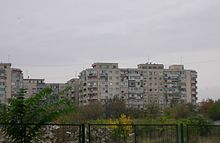

Vitan is a neighborhood in southeastern Bucharest, Romania, along the Dâmbovița River. It is located in Sector 3, and lies between the Titan, Dristor, Centrul Civic, Olteniței, and Berceni districts.
According to Dimitrie Papazoglu, its name comes from the Vitan Plain, where the cattle of the townspeople once grazed,[1] while according to historian Adrian Majuru, the neighborhood's name comes from the name of a property owner, whose estate subsequently became a village that was later incorporated into the city.[2] Though it is one of the oldest neighborhoods of Bucharest, it was for a long time notorious for its poverty. The Bucharest Mall is situated in the north side of the neighborhood, while the Târca–Vitan Church is located on Calea Vitan. The now drained Lake Văcărești is located on the right bank of the Dâmbovița and the use of the 3.06 km2 (1.18 sq mi) of land owned by the state (evaluated to about $650 million) is still undecided. The neighborhood was mostly erased to allow for prefabricated apartment buildings to be constructed on their site between 1986 and 1992, with typical architecture of the era (buildings inspired from North Korean designs)[citation needed]. Previously, the only new buildings in the area were the Vitan Post Office (1956) and Polyclinic (1967).
References
[edit]- ^ Monica Cosac (March 14, 2018). "De la pășune pentru vite, la mall". www.bucuresti-centenar.ro (in Romanian). Retrieved May 21, 2021.
- ^ Victor Cozmei (September 21, 2019). "Cum și-au luat numele cartierele din București. De unde vin denumirile Militari, Drumul Taberei, Vitan, Ghencea, Giulești, Dristor sau Balta Albă". HotNews (in Romanian). Retrieved May 21, 2021.

Well, that’s interesting to know that Psilotum nudum are known as whisk ferns. Psilotum nudum is the commoner species of the two. While the P. flaccidum is a rare species and is found in the tropical islands. Both the species are usually epiphytic in habit and grow upon tree ferns. These species may also be terrestrial and grow in humus or in the crevices of the rocks.
View the detailed Guide of Psilotum nudum: Detailed Study Of Psilotum Nudum (Whisk Fern), Classification, Anatomy, Reproduction